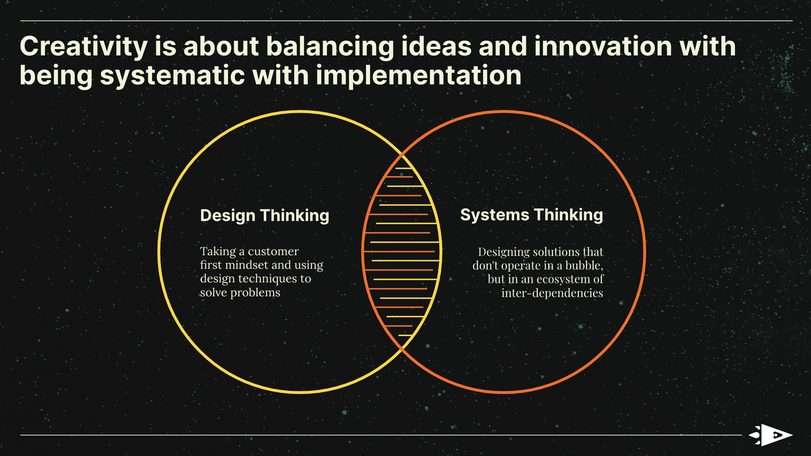
partner content
Don't think harder, think smarter: Bringing Design and Systems Thinking together
VCCP Bernadette's Steph Marques, head of UX and Iva Johan, chief strategy officer, explore the benefits of combining design and system thinking
19 January 2024
We see them every day; stories of failed start-ups, digital transformation flops and customer experience fails - successful digital products are incredibly hard to achieve.
There are many, many reasons for this, but one of the key contributing factors we’ve seen is one-dimensional thinking. The digital industry is famous for championing empathetic Design Thinking with customers at the heart, and interestingly in contrast to this, is also synonymous with business-orientation and seeing “the big picture” through analytical Systems Thinking. However, very rarely do we see both mindsets being used hand-in-hand.
All too often design and product led teams are over indexing in their Design Thinking approaches to solving problems, and at the other end of the spectrum, operations and business led teams are leaning too heavily into a Systems Thinking approach.
In the case where a team is taking a purely Design Thinking approach, it can mean that although customers love the product, it might not be operationally, or financially feasible. If you’ve ever heard, “That’s such a great idea… but it’s going to take us three years to deliver” or “...but it’s never going to make us any money” - then you’ve probably fallen into this trap.
On the other hand, taking a purely Systems Thinking approach could lead to a technically or operationally sound idea, yet completely forgetting about what the customer needs. This often ends up with lots of business requirements that make sense for the business in theory but in reality are solutions to problems that customers simply don’t have. Or solutions that don’t solve an actual problem. An example of this we all probably know is the Segway - an e-mobility scooter that was meant to solve a mobility problem, but it was either too fast or too slow depending on where you wanted to use it, it was heavy and clunky, so not really mobile, and ultimately it was too expensive. In theory it solved a customer problem, but many will make the argument that it was a technology innovation looking for a problem.
Interestingly, if we look back to user experience and product design of the past, to the days when it was all about Information Architecture in the 2000s, you can clearly see that the profession was very Systems Thinking orientated. Information Architects had a lot to sort out. Businesses were setting up their online presences for the first time, and this meant that designers needed to create digital structures that represented entire companies. They had to step back, look at companies as a whole, unpick the system and then build out a structure that customers could easily navigate, from the ground up.
Fast forward to the 2020s and things have changed. Digital presences have been established and there are thousands of blueprints for information architecture out there that are easy to lift and shift. Now if you take a look at any ‘Become a Product Designer in just [insert incredibly short length of time here]’ courses, you’ll see that the syllabus will be almost entirely orientated around Design Thinking - about putting the customer first and designing for their needs. So within two decades we’ve completely switched mindsets - the art-forms of I.A. and systems mapping have been somewhat forgotten, and this is a big mistake.
In our industry, a lot has been written about the topics of Design Thinking and Systems Thinking separately - evangelising and teaching the formulas that can be applied to digital product design and build. And, to be fair, there are articles out there about combining the two - so we are not covering new theoretical ground here - but we know from experience that very little has been done to take the theory of this powerful combination into practice.
When working with Cadbury on reimagining their website, combining the two thinking styles allowed us to take our original brief from what was a simple website redesign, to unlocking real opportunities by defining a new purpose for the website in the wider ecosystem. One way we did that was by looking at the customer’s journey as a system, beyond the website and even beyond just looking at digital, we asked ourselves - what role can and should the website play in that customer journey?
We are also currently working with Italy specialist Tour Operator, Citalia, who came to us with a simple brief - to improve the conversion rate of their site. In this case, it’s very important to think of their business as a system, to make sure that the optimisation work we do is feeding into what the business is trying to achieve - especially as previously they had a mismatch between the website and the underlying business model. Taking this approach is leading to positive results from the get go.
We believe that we have to challenge ourselves to open up to other ways of looking at problems. We can’t rest on the core skills from any one discipline. We have to combine customer-centricity with business thinking and operational feasibility.
We have come to the realisation that how teams think and how they approach problem solving, is fundamental to a product’s success. A team’s mindset alone is one of the most important factors in whether their app, service or feature will be a success or a failure.
The question is, are you a design thinker, or a systems thinker by trade? Are you stuck in a comfortable groove of one way of thinking? When was the last time you swapped spreadsheets for a sketchpad, or customer testing for stakeholder interviews? Ok, we’re deliberately poking the bear here, but you get the picture. We have a duty to mix both ways of thinking in order to give the products and services we create the greatest chance of being successful.
So, what will you do to step out of your comfortable thinking zone? Whatever it is, we’re sure you and your Product Owners won’t regret it.
Steph Marques is the head of UX and Iva Johan is the chief strategy officer at Bernadette, VCCP’s digital innovation company









